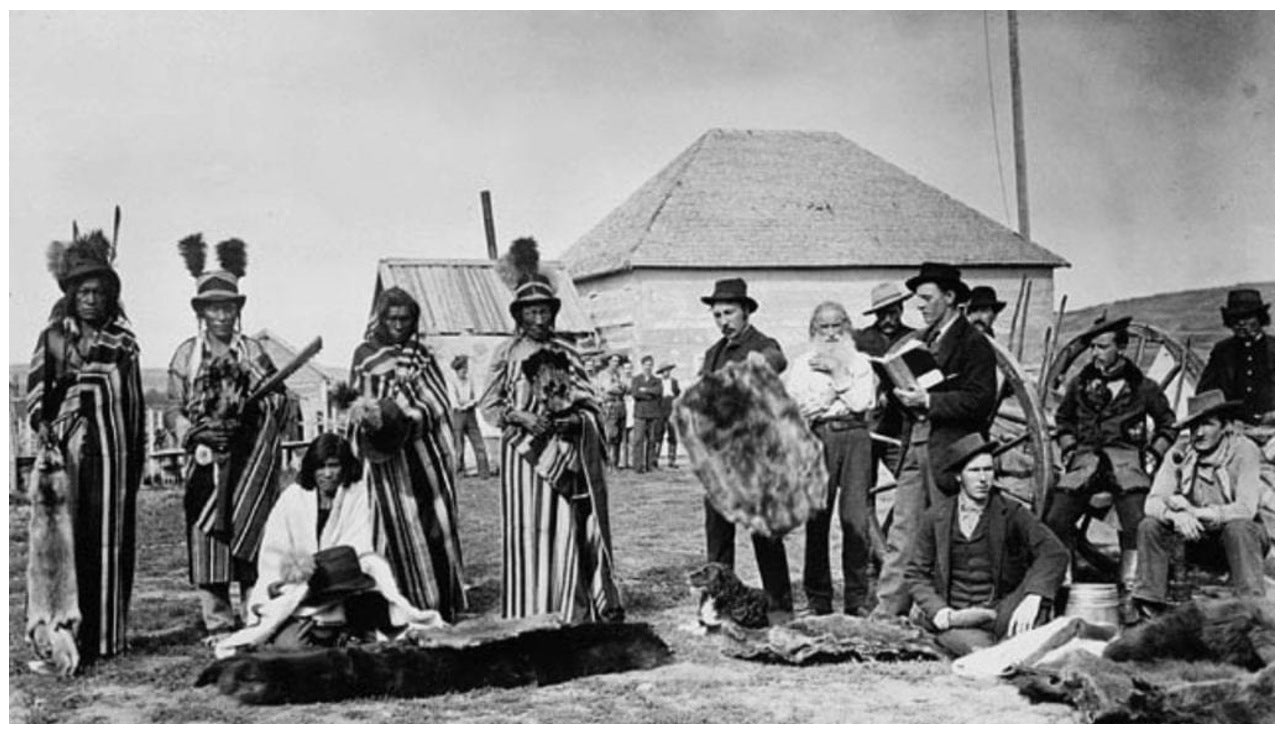
The arrival of European explorers and settlers brought to the North American continent, alongside much upheaval for the Indigenous people, exciting new and diverse trade opportunities that were, at times, mutually beneficial.
The Native American tribes and the first Europeans in North America attempted to build relationships based primarily on trade. While disease and conflict soon led to many of these fledgling relationships deteriorating, the Native Americans became very intrigued by what these new strangers could offer – which would soon be incorporated into their daily lives. Conversely, the Europeans needed the assistance of the Native Americans and the resources they could offer, especially for their very survival in the early years of the white colony.
Diverse New Trade Opportunities…
Native hunters of the Northeast (the first to have contact with the white settlers) enthusiastically traded prepared pelts (including deer hides) for lengths of colored woven cloth from wool, linen, and cotton.
Metal items like iron pots and kettles were prized and almost immediately replaced their traditional bark and clay equivalents, as well as being repurposed into new tools and weapons. Knives, axes, and hoes were also highly sought after by the Native people. Bows and arrows were replaced where possible by guns, gunpowder, and lead shot.
Exciting new items like glass beads were incorporated into Native handicrafts and used to decorate clothing.
A strong desire for these new goods altered trading patterns and practices that had been followed for thousands of years. The availability of valuable new resources forever changed how Native Americans lived and traded in their daily lives, and most tribes eventually became dependent on these trade goods for prosperity and efficiency.
For example, simple Native hunting traditions became less important than hunting focused on hides for trading purposes. Other items the Natives now actively sought from the white settlers included thread, twine, brass, copper, tinware, tobacco, pipes, candles, fishing equipment, hats shoes, silk, soap, stockings/hose, seeds, umbrellas, liquor (especially rum), and much more.
Overall, fabric was the most popular of trade goods, followed by tools and weapons, liquor, and jewelry items.
Fur Trade…
Long extant between tribes before European arrival, the fur trade ramped up after the mid-1600s and lasted for 200 years, as European-American traders exchanged their manufactured goods with Native Americans for animal furs. Furs were very valuable and highly sought by the new settlers as well as for shipment back to Europe.
In particular, trade alliances with the Dakota and Ojibwe were extremely important as they were the primary trappers of furred animals in the Northwest. Furs from a diverse range of animals were harvested in the woodlands and waterways of these ancestral lands, and Beaver fur was considered to be the most valuable.
So important was trade with Native Americans to the British and French, in particular, that a lot of European Americans who worked in the fur trade adopted Native protocols and customs for meeting, bartering, and diplomacy.
By the end of the American Revolution, the fur trade was a collaborative effort between the Native Americans, the US government, and fur trading companies. Incidentally, many travelling fur traders (“voyageurs”) married Native women and integrated into their Native kinship and community networks – examples of a new cultural diversity that directly arose from the fur trade in the Northwest.
Blanket Trade…
Before European arrival, Native Americans clothed themselves in animal furs and skins; hunted animals like Bison were used in their entirety with no part wasted. Hides were tanned and pelts were sewn together - fur was usually worn against the skin.
The white wool Witney blankets brought by the Europeans were initially extremely problematic, as they carried diseases from smallpox to viruses to which the Natives had never been exposed and had no natural immunity. This was tragic for Native populations. They were, however, also deemed by the Natives to be advantageous for apparel: wool dried faster and smelled better when wet than animal furs and skins, was lighter, and protected well against both cold and wind. Blankets were traded to the Native Americans and worn as-is or cut and made into vests, coats, capots, and other apparel.
It was this love of blankets that led to the renowned Native American blanket trade and Pendleton Woolen Mills’ creation of American Indian blanket designs that endure to this day.
(Photo at Top of Article: L-R: Four Sky Thunder, Sky Bird, Matoose, Napasis, Big Bear, Angus McKay, Otto Dufresne, Louis Goulet, Stanley Simpson, Mr Rowley, Alex McDonald, Captain R.B. Sletch, Mr Edmund, & Henry Dufrain)
